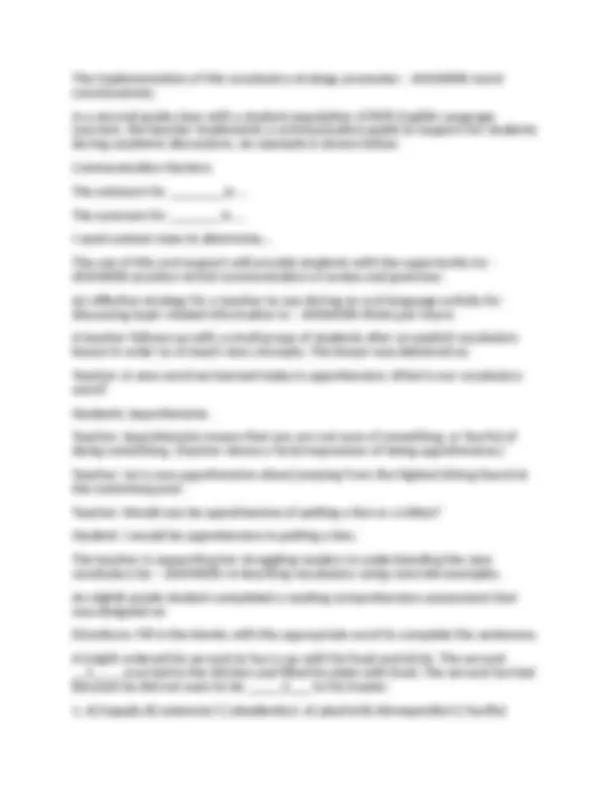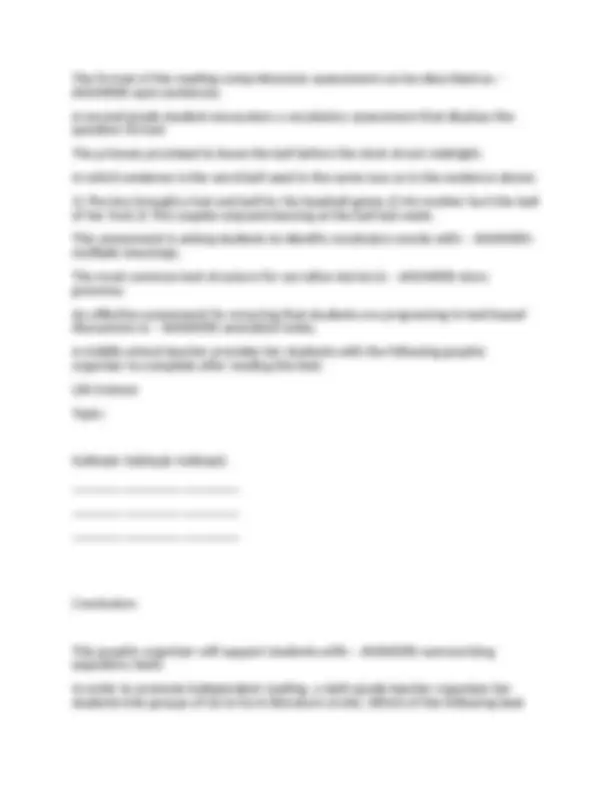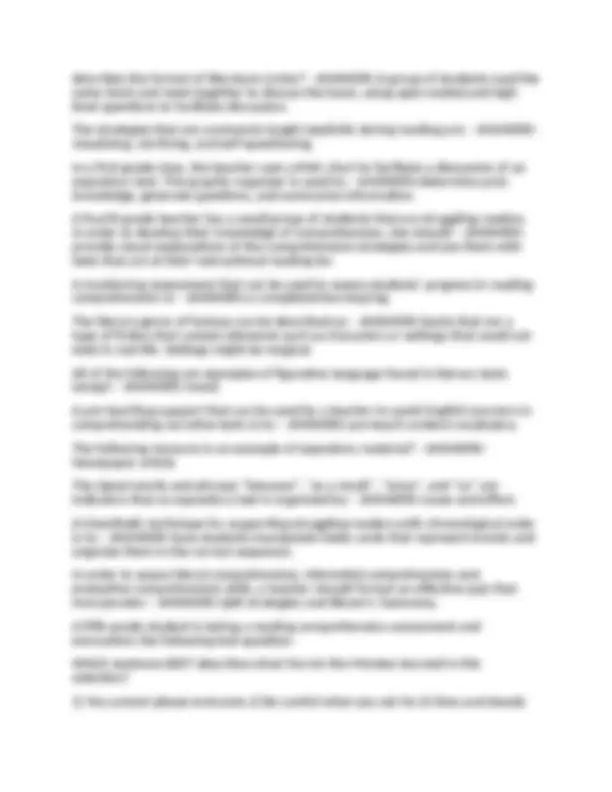





Study with the several resources on Docsity

Earn points by helping other students or get them with a premium plan


Prepare for your exams
Study with the several resources on Docsity

Earn points to download
Earn points by helping other students or get them with a premium plan
Community
Ask the community for help and clear up your study doubts
Discover the best universities in your country according to Docsity users
Free resources
Download our free guides on studying techniques, anxiety management strategies, and thesis advice from Docsity tutors
RICA subtest 2 | 100% Correct Answers 2025 Graded A+ Pass. RICA subtest 2 | 100% Correct Answers 2025 Graded A+ Pass.
Typology: Exams
1 / 6

This page cannot be seen from the preview
Don't miss anything!




An example of a reading comprehension statement written in academic language is: - ANSWERS-I am going to visualize what is happening in the selection. Before reading the story, Look Out Kindergarten, Here I Come, the teacher brought in realia (pencils, scissors, crayons, glue, paper) to support her students with vocabulary that will be encountered in the story and discussed the characteristics. This vocabulary lesson will allow students to: - ANSWERS-develop background knowledge to support comprehension of new information. A vocabulary strategy that supports early vocabulary development for students is:
Read a familiar sentence that includes the target word. Ask students to identify any context clues that can support them in determining the meaning of the target word. Ask students to predict meaning and synonyms for target word. Confirm accurate meaning, using a student-friendly definition. This lesson is an example of: - ANSWERS-direct instruction of vocabulary The graphic organizer above is an example of a: - ANSWERS-semantic map. Use the illustration below to answer the question that follows. The graphic organizer above will support students in developing vocabulary knowledge relating to: - ANSWERS-word roots. A fourth-grade teacher writes the following sentence on the board during a vocabulary lesson: "The paleontologist, a dinosaur scientist, used a magnifying glass to determine the type of fossil found during an expedition in the desert." In order to find the meaning of "paleontologist" using a word-learning strategy, the teacher is teaching a directed lesson on: - ANSWERS-apposition. A third-grade teacher implements a long-term vocabulary activity for her students called Word Wizard. The students will be provided with weekly vocabulary words. If they encounter any of the words outside of direct instruction, the students have to fill out an index card identifying the word, how it was used (conversation, television, magazine, etc.) and explain its meaning. The teacher will place these cards in the Word Wizard's bucket. The student with the most words in the bucket at the end of the week receives a prize.
The format of the reading comprehension assessment can be described as: - ANSWERS-opin sentences. A second-grade student encounters a vocabulary assessment that displays the question format: The princess promised to leave the ball before the clock struck midnight. In which sentence is the word ball used in the same way as in the sentence above:
Conclusion: This graphic organizer will support students with: - ANSWERS-summarizing expository texts In order to promote independent reading, a sixth-grade teacher organizes her students into groups of six to form literature circles. Which of the following best
describes the format of literature circles? - ANSWERS-A group of students read the same book and meet together to discuss the book, using open-ended and high level questions to facilitate discussion. The strategies that are commonly taught explicitly during reading are: - ANSWERS- visualizing, clarifying, and self-questioning. In a first-grade class, the teacher uses a KWL chart to facilitate a discussion of an expository text. This graphic organizer is used to: - ANSWERS-determine prior knowledge, generate questions, and summarize information. A fourth-grade teacher has a small group of students that are struggling readers. In order to develop their knowledge of comprehension, she should: - ANSWERS- provide visual explanations of the comprehension strategies and use them with texts that are at their instructional reading lev A monitoring assessment that can be used to assess students' progress in reading comprehension is: - ANSWERS-a completed learning log. The literary genre of fantasy can be described as: - ANSWERS-books that are a type of fiction that contain elements such as characters or settings that could not exist in real-life. Settings might be magical. All of the following are examples of figurative language found in literary texts except: - ANSWERS-mood. A pre-teaching support that can be used by a teacher to assist English Learners in comprehending narrative texts is to: - ANSWERS-pre-teach content vocabulary. The following resource is an example of expository material? - ANSWERS- Newspaper article The signal words and phrases "because", "as a result", "since", and "so" are indicators that an expository text is organized by: - ANSWERS-cause and effect. A kinesthetic technique for supporting struggling readers with chronological order is to: - ANSWERS-have students manipulate index cards that represent events and organize them in the correct sequence. In order to assess literal comprehension, inferential comprehension and evaluative comprehension skills, a teacher should format an effective quiz that incorporates: - ANSWERS-QAR strategies and Bloom's Taxonomy. A fifth-grade student is taking a reading comprehension assessment and encounters the following test question: Which sentence BEST describes what Marvin the Monkey learned in this selection?